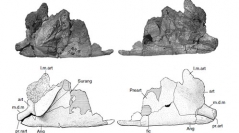

 Geodiversitas
27 (1) - Pages 35-132
Geodiversitas
27 (1) - Pages 35-132The pareiasaur material described herein is derived from the lithostratigraphic unit T2 (Tourbihine Member) of the Late Permian Ikakern Formation of the Argana Basin (Morocco). It includes a new taxon, Arganaceras vacanti n. gen., n. sp., which is represented by a single, almost complete skull. This material also includes various postcranial elements from different localities, but from the same lithostratigraphic unit, and which belong to two different forms, provisionally referred to here as “Pareiasauria gen. et sp. indet. 1” and “Pareiasauria gen. et sp. indet. 2”. The study of the phylogenetic relationships of the Argana pareiasaurs has led to a reconsideration of the characters recently used in pareiasaur phylogeny reconstructions. The phylogenetic analysis presented here is based on a data matrix of 128 characters and 32 taxa. Arganaceras vacanti n. gen., n. sp. appears as a much derived form, closely related to Elginia mirabilis Newton, 1893, from the Late Permian of Scotland, with which it shares three synapomorphies: 1) much developed supernumerary bones, excluding the postparietals from the posterior skullroof margin; 2) prominent, horn-shaped and sharp quadratojugal tubercles; and 3) dermal bone ornamentation comprizing prominent and horn-shaped central bosses. Arganaceras n. gen. and Elginia may be regarded as closely related to the unnamed Kupferschiefer pareiasaur, from the Late Permian of Germany, on the basis of one synapomorphy (supernumerary bones well developed and extending posteriorly behind the level of the postparietals). Arganaceras vacanti n. gen., n. sp. differs from all other pareiasaurs by 11 autapomorphies: 1) posteriorly sloping anterior process of the maxillary (the ventral margin of the external nostril is thus more horizontal than in other pareiasaurs); 2) very large supernumerary bones, with a large ventral blade joining the supratemporal ventrally; 3) internal crest of the supernumerary bone, which prolongs dorsally the internal crest of the squamosal and supratemporal and thus suggests a contribution of the supernumerary bone to the contact with the paroccipital process of the opisthotic; 4) well developed medial processes of the exoccipitals, excluding the supra-occipital from the margin of the foramen magnum; 5) narrow and elongated braincase, with a conspicuous lateral constriction of the parabasisphenoid; 6) laterally compressed and elongated basipterygoid processes; 7) sella turcica with vertical anterior wall and opening dorsally; 8) two lateral tubercles on the ventral surface of the basioccipital, on either sides of the median tubercle; 9) large retroarticular process made up by the articular and angular; 10) large bony blade arising from the articular and bounding off the glenoid fossa medially; and 11) anteroventrally directed maxillary teeth. The stapes, hitherto unknown in pareiasaurs, is described herein for the first time and displays a remarkably derived morphology, quite similar to that of the stapes of modern sauropsids. The nature of the supernumerary bone of pareiasaurs is discussed. Its perfect integration to the skull roof, with a large ventral blade that attaches the supratemporal to its ventral surface, suggests that it is a neoformation, rather than the tabular or an osteoderm included into the skull table. No detailed reconstruction of the skull of A. vacanti n. gen., n. sp. is proposed, in order to avoid future character analyses using such an approximate and possibly misleading reconstruction. The phylogenetic analysis suggests that the Pareiasauria gen. et sp. indet. 1 is the sister-group of the Pumiliopareiasauria, with which it shares two synapomorphies (narrow and rounded ectepicondyle and iliac plate not extended anteriorly). The Pareiasauria gen. et sp. indet. 2 differs from the Pareiasauria gen. et sp. indet. 1 by its less swollen neural arches in anterior and posterior views; neural spines not laterally compressed; narrower pre- and post-zygapophyses; ventrally narrower iliac plate, with an anteriorly tilted corpus of the ilium; and more anteriorly curved proximal head of the femur. The phylogenetic analysis shows that this pareiasaur belongs to the Therischia, but its relationships within this taxon are unresolved. The characters of the Pareiasauria gen. et sp. indet. 2 are compatible with the phylogenetic position of Arganaceras vacanti n. gen., n. sp. and this postcranial material may in fact belong to either this species, or a closely related one. The close relationships between Arganaceras vacanti n. gen., n. sp. and Elginia mirabilis suggest a latest Permian age, probably late Tatarian, for the top of the lithostratigraphic unit T2 of the Ikakern Formation.
Parareptilia, Pareiasauria, Permian, Morocco, anatomy, phylogeny, biostratigraphy, new genus, new species